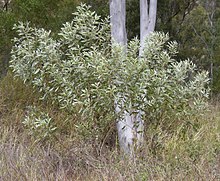Acacia holosericea
Appearance
| Strap wattle | |
|---|---|

| |
| Scientific classification | |
| Kingdom: | Plantae |
| Clade: | Tracheophytes |
| Clade: | Angiosperms |
| Clade: | Eudicots |
| Clade: | Rosids |
| Order: | Fabales |
| Family: | Fabaceae |
| Subfamily: | Caesalpinioideae |
| Clade: | Mimosoid clade |
| Genus: | Acacia |
| Species: | A. holosericea
|
| Binomial name | |
| Acacia holosericea | |

| |
| Occurrence data from AVH | |

Acacia holosericea is a shrub native to
tropical and inland northern Australia. It is commonly known as soapbush wattle, soapbush,[1] strap wattle, candelabra wattle,[2] silver wattle[2] and silky wattle.[3]
Description
The shrub has a spreading habit and typically grows to a height of 3 m (9.8 ft) and a width of 4 m (13 ft).seed pods that form after flowering are tightly irregularly coiled and have a width of 2.5 to 4 mm (0.1 to 0.2 in).[2] The pods are 3 to 5 cm (1.2 to 2.0 in) in length and twisted and curled.[5] The shiny dark brown seeds are arranged longitudinally in the pods and have an obloid-ellipsoid shape and are 3 to 5 mm (0.1 to 0.2 in) in length with a bright yellow aril.[2] The seed is edible.[6][7]
Taxonomy
The species was first formally described by the botanist
Port Keats on the edge of the Cambridge Gulf.[3]
Distribution
The shrub is found in northern parts of Australia in
ephemeral watercourses growing in gravelly sand or loamy soils.[2]
Cultivation
A. holosericea is available for cultivation by seed, although the seeds must be
scarified
prior to planting. It grows quickly and well in a sunny, reasonably well drained position in most soil types. It is suitable as a feature plant or as a hedge or screen plant.
It has attractive foliage and fruit and can be grown in tropical areas.[4]
Uses
See also
References
- ^ "Acacia holosericea A.Cunn. ex G.Don". Wattle - Acacias of Australia. Department of the Environment and Energy. Retrieved 11 August 2019.
- ^ a b c d e "Acacia holosericea". Wattles of the Pilbara. Department of Environment and Conservation. 2010. Retrieved 11 August 2019.
- ^ a b c F.A.Zich; B.P.M.Hyland; T.Whiffen; R.A.Kerrigan (2020). "Acacia holosericea". Australian Tropical Rainforest Plants (RFK8). Centre for Australian National Biodiversity Research (CANBR), Australian Government. Retrieved 27 May 2021.
- ^ a b c "Acacia holosericea". Wattles - Genus Acacia. Australian National Botanic Gardens. Retrieved 10 August 2019.
- ISBN 0-85091-143-5
- ^ ISBN 0-207-16930-6
- ^
NFTA 88-04 (August 1988), Acacia holosericea - A Successful Newcomer for the Dry Tropics, archived from the original on 22 March 2016
{{citation}}: CS1 maint: numeric names: authors list (link) - ^ "Acacia holosericea A.Cunn. ex G.Don". Atlas of Living Australia. Global Biodiversity Information Facility. Retrieved 11 August 2019.
External links
- Dressler, S.; Schmidt, M. & Zizka, G. (2014). "Acacia holosericea". African plants – a Photo Guide. Frankfurt/Main: Forschungsinstitut Senckenberg.
